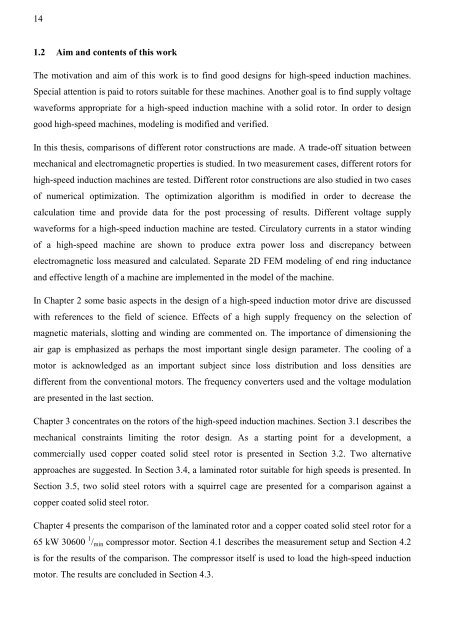Design and Voltage Supply of High-Speed Induction - Aaltodoc
Design and Voltage Supply of High-Speed Induction - Aaltodoc
Design and Voltage Supply of High-Speed Induction - Aaltodoc
You also want an ePaper? Increase the reach of your titles
YUMPU automatically turns print PDFs into web optimized ePapers that Google loves.
14<br />
1.2 Aim <strong>and</strong> contents <strong>of</strong> this work<br />
The motivation <strong>and</strong> aim <strong>of</strong> this work is to find good designs for high-speed induction machines.<br />
Special attention is paid to rotors suitable for these machines. Another goal is to find supply voltage<br />
waveforms appropriate for a high-speed induction machine with a solid rotor. In order to design<br />
good high-speed machines, modeling is modified <strong>and</strong> verified.<br />
In this thesis, comparisons <strong>of</strong> different rotor constructions are made. A trade-<strong>of</strong>f situation between<br />
mechanical <strong>and</strong> electromagnetic properties is studied. In two measurement cases, different rotors for<br />
high-speed induction machines are tested. Different rotor constructions are also studied in two cases<br />
<strong>of</strong> numerical optimization. The optimization algorithm is modified in order to decrease the<br />
calculation time <strong>and</strong> provide data for the post processing <strong>of</strong> results. Different voltage supply<br />
waveforms for a high-speed induction machine are tested. Circulatory currents in a stator winding<br />
<strong>of</strong> a high-speed machine are shown to produce extra power loss <strong>and</strong> discrepancy between<br />
electromagnetic loss measured <strong>and</strong> calculated. Separate 2D FEM modeling <strong>of</strong> end ring inductance<br />
<strong>and</strong> effective length <strong>of</strong> a machine are implemented in the model <strong>of</strong> the machine.<br />
In Chapter 2 some basic aspects in the design <strong>of</strong> a high-speed induction motor drive are discussed<br />
with references to the field <strong>of</strong> science. Effects <strong>of</strong> a high supply frequency on the selection <strong>of</strong><br />
magnetic materials, slotting <strong>and</strong> winding are commented on. The importance <strong>of</strong> dimensioning the<br />
air gap is emphasized as perhaps the most important single design parameter. The cooling <strong>of</strong> a<br />
motor is acknowledged as an important subject since loss distribution <strong>and</strong> loss densities are<br />
different from the conventional motors. The frequency converters used <strong>and</strong> the voltage modulation<br />
are presented in the last section.<br />
Chapter 3 concentrates on the rotors <strong>of</strong> the high-speed induction machines. Section 3.1 describes the<br />
mechanical constraints limiting the rotor design. As a starting point for a development, a<br />
commercially used copper coated solid steel rotor is presented in Section 3.2. Two alternative<br />
approaches are suggested. In Section 3.4, a laminated rotor suitable for high speeds is presented. In<br />
Section 3.5, two solid steel rotors with a squirrel cage are presented for a comparison against a<br />
copper coated solid steel rotor.<br />
Chapter 4 presents the comparison <strong>of</strong> the laminated rotor <strong>and</strong> a copper coated solid steel rotor for a<br />
65 kW 30600 1 /min compressor motor. Section 4.1 describes the measurement setup <strong>and</strong> Section 4.2<br />
is for the results <strong>of</strong> the comparison. The compressor itself is used to load the high-speed induction<br />
motor. The results are concluded in Section 4.3.
















